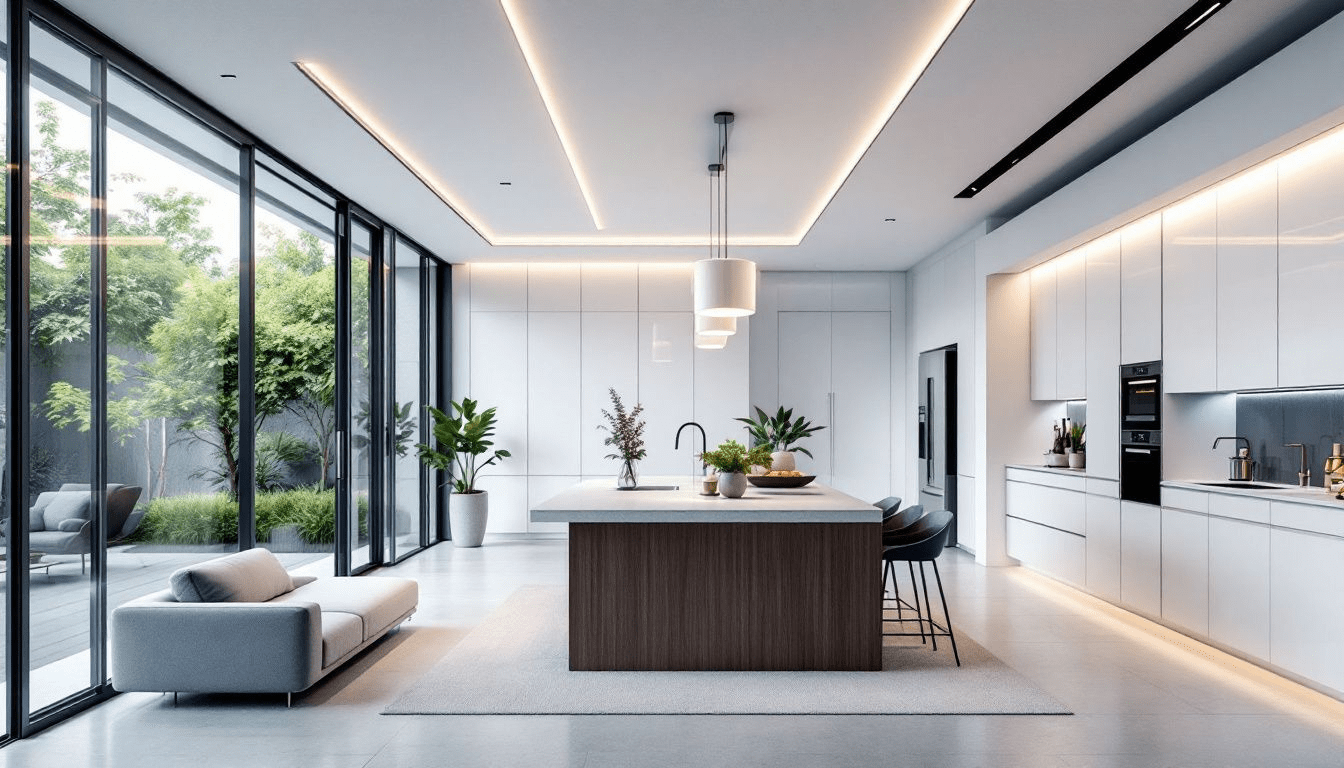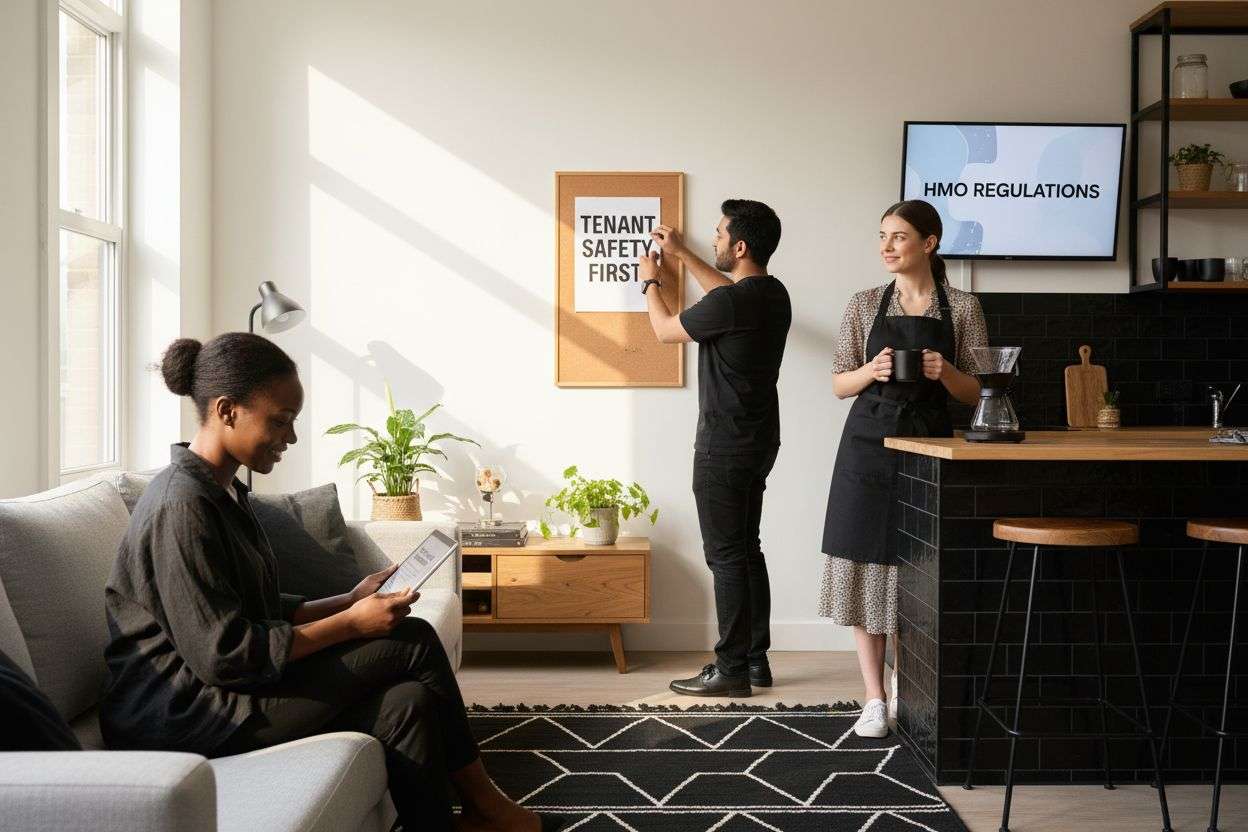In overseeing a House in Multiple Occupation (HMO), it is crucial to be well-informed about the minimum room sizes stipulated for HMOs. This overview delineates the dimensional prerequisites for spaces such as bedrooms, kitchens, and bathrooms to comply with legal regulations and afford tenants an adequately comfortable living area.
The government plays a significant role in setting guidelines and regulations for minimum room sizes in HMOs, ensuring high-quality living conditions and legal compliance for landlords and investors.
Key Takeaways
HMO regulations mandate specific minimum room sizes, requiring single occupancy bedrooms to be at least 6.51 square meters and double occupancy bedrooms 10.22 square meters to ensure tenant comfort and safety.
Landlords must obtain planning permission and an HMO license if their property has more than six occupants, adhering to local authority regulations to avoid legal consequences. Various standards and conditions apply to qualify for an HMO license, including specific regulations governing room sizes and other requirements.
Effective space optimization strategies, including intelligent interior design and creating communal areas, can enhance tenant satisfaction while ensuring compliance with HMO standards.
Minimum Room Size Requirements for HMOs
Adhering to the minimum room size standards is a pivotal aspect of HMO regulations designed to ensure that tenants enjoy sufficient space for living. The national guidelines established since October 2018 stipulate the exact floor area necessary for rooms such as bedrooms, kitchens, and bathrooms within HMOs. These minimum sizes are imposed by law and must be adhered to by landlords. This measure combats overcrowding and upholds quality living conditions by defining what constitutes an acceptable room size, with local authorities responsible for carrying out checks to guarantee compliance.
Additionally, HMO licenses outline the maximum number of residents allowed in the property, including specific limits per room, which landlords must adhere to in order to avoid penalties.
Landlords who manage HMO properties must be aware that ignoring these specific space requirements can lead to substantial penalties or even legal action against them. It is crucial for landlords managing an HMO property to grasp these regulations thoroughly in order to preserve their license status while providing safe and comfortable accommodation for all tenants.
Bedroom Sizes
HMO bedrooms are required to adhere to certain minimum size requirements to ensure they are suitable for occupant comfort and practical use. A bedroom intended for one person must be at least 6.51 square meters in floor area, while those meant for two people need a larger space of no less than 10.22 square meters.
For the purposes of these measurements, only parts of the room where the ceiling height is over 1.5 meters count towards this total floor area. Additionally, bedrooms for children under 10 years must meet specific minimum size requirements as per local authority regulations.
To be adequately sized, bedrooms should offer enough room for necessary furnishings as well as comfortable maneuverability within the space provided by HMO landlords, which serves both practicality and tenant welfare aspects.
These regulations regarding minimum room sizes play a crucial role in enabling HMO landlords to present accommodations that not only meet legal standards set by local authorities but also foster contentment among tenants through livable conditions.
Room configurations designed to accommodate couples comfortably, such as those with a king-size bed option, are also important considerations for landlords aiming to provide flexible and comfortable living spaces.
Kitchen Sizes
Kitchens in HMOs must meet specific minimum size requirements to accommodate cooking activities and ensure tenant comfort. The minimum floor area for an HMO kitchen is 7 square meters, with an additional 1 square meter required for every tenant exceeding five. This ensures that kitchens are spacious enough to support all occupants’ needs.
Additionally, considering sink and drainer sizes is crucial for tenant comfort and compliance with regulations. A well-designed space with adequate amenities, like sinks, can positively impact tenant satisfaction and minimize maintenance issues, making it beneficial for both landlords and tenants.
Complying with these size requirements helps landlords create practical kitchens that meet HMO regulations.
Bathroom Sizes
Regulations dictate that bathrooms in HMOs must adhere to certain size standards, ensuring cleanliness and comfort for the occupants. Such a bathroom normally features either a bath or shower area. To accommodate the number of tenants effectively, regulations stipulate that there should ideally be one bathroom designated for children per every three residents.
The implications of occupancy levels on minimum size requirements for bathrooms are significant, as more occupied spaces necessitate larger or additional facilities to maintain comfort and safety.
In cases where there is an additional toilet separate from the main bathroom, it is required to include a wash hand basin with access to both hot and cold water within the same space. Upholding these criteria helps assure adequate sanitary conditions and comfort levels for those residing in HMO properties.
Ceiling Height Considerations
Ceiling height is crucial in determining the usability and compliance of rooms in HMOs. Areas with ceiling heights under 1.5 meters do not count towards the minimum square footage required for compliance. Landlords must ensure the majority of the room has sufficient ceiling height to meet standards.
In addition to following minimum size regulations, landlords must consider ceiling height when calculating usable floor space.
Properly measuring and, if necessary, modifying ceiling heights can help maximize usable floor area and ensure compliance with HMO regulations.
Measuring Ceiling Heights
Ensuring that the height of ceilings complies with regulations governing HMO room sizes is essential. To accurately measure the ceiling height, a tape measure should be positioned at the floor and extended to the highest point of the ceiling. It’s important to note that only portions where the ceiling height exceeds 1.5 meters are considered as contributing to legally required living space.
Landlords must take precise measurements in order to ascertain their rooms’ compliance with set standards within an HMO setting, making any requisite modifications when spaces fall short of these requirements.
Modifying Ceiling Heights
In instances where HMOs present with low ceiling issues, adjusting the height of ceilings may provide a practical resolution. Elevating the overall ceiling height is one potential method. Doing so might necessitate obtaining planning permission and could incur considerable expenses.
An alternative solution would be to reconfigure the existing space into two separate smaller rooms if it significantly falls short of meeting the standard required ceiling height.
Opting for a lowered or suspended ceiling can also fulfill regulation standards while preserving an appealing look within the property. Employing lighter shades in painting these lower ceilings can foster a sense of increased vertical space, thereby enhancing spatial perception.
By investigating these alternatives, landlords are better equipped to ensure their properties conform with regulations that govern HMOs and offer tenants accommodating living spaces.
Optimizing Space in HMOs

Creative design is key in maximizing both occupancy and functionality within HMOs. To ensure that tenants enjoy a living environment that is not only comfortable but also efficient, it’s essential to utilize every square meter effectively. This can be achieved by integrating multifunctional furnishings such as beds equipped with storage areas and adaptable furniture pieces, which greatly improve the use of space and overall tenant satisfaction.
Design functions as a form of communication, enhancing tenant experiences and attracting long-term renters.
Engaging an expert specializing in HMO architecture could offer novel approaches to reorganize layouts and transform individual rooms into communal spaces. Such innovations have the potential to amplify the income generated from the property while enhancing its practicality for tenants.
Dividing Large Rooms
Partitioning substantial rooms can optimize space utilization within HMOs while adhering to regulations for minimum room sizes. As an example, a sizable bedroom could be converted into two smaller rooms, as long as the dimensions of each resulting room adhere to established standards for minimum size. Certain areas should be excluded from the total floor area measurement when dividing large rooms. By doing so, it’s possible to augment the number of tenants and simultaneously maintain conformity with stipulated HMO guidelines.
Ensuring safety and fostering comfort must remain at the forefront when making modifications—integrating elements that reduce hazards and improve living conditions for every occupant is crucial.
Utilizing Communal Areas
Revamping underutilized areas into shared spaces can greatly increase the attractiveness and practicality of a House in Multiple Occupation (HMO). These communal areas must be adequately large to comfortably serve numerous tenants while fostering social engagement. Incorporating enough storage options within these designs can help keep the space neat, ensuring a welcoming atmosphere for occupants.
The unique nature of HMOs, such as shared living spaces and the necessity for efficient design, dictates specific regulations and design strategies to optimize the living experience for multiple occupants.
In properties with more than five tenants, it is essential to have a dedicated dining room or an additional living room with a minimum size of 11m2 to enhance the living experience and comply with HMO regulations.
Transforming seldom-used regions like basements or attics into collective spaces can significantly elevate an HMO’s comfort level. Converting these zones provides residents with an extra living room area where they may unwind and interact, whether it’s used as additional living rooms, dining rooms, or common workspaces suitable for multiple occupation scenarios.
Optimizing the layout and arrangement of communal sections is pivotal in improving the overall experience for tenants and promoting the success of your property investment.
Storage Solutions
Enhancing space efficiency in HMOs is vital, and innovative storage solutions play a key role. Options like built-in wardrobes and shelving units can greatly enhance the functionality of both rooms and communal spaces.
To meet space requirements and offer sufficient storage for tenants, bedrooms must feature suitable storage facilities. By implementing these solutions, landlords are able to establish well-organized and practical living spaces that adhere to the standards required for HMO compliance.
Planning Permission and Licensing
Landlords are obligated to comply with regulations and secure the appropriate planning permissions and licenses for effective HMO management, which includes adherence to space standards. Licensed HMOs must comply with specific conditions and standards set by local authorities. These measures are enforced by local housing authorities through licensing to ensure that properties meet minimum safety requirements. By following these guidelines, landlords can guarantee safe and habitable conditions for their tenants while steering clear of any legal consequences.
When Planning Permission is Needed
For HMOs accommodating over six occupants, planning permission is mandatory. Converting a property into an HMO requires planning consent if the local council has withdrawn rights for permitted development. Landlords overseeing large HMOs—which are categorized by housing five or more tenants—must secure a compulsory license specific to HMO operations.
Those in control of properties must adhere to legal occupancy limits, ensuring compliance with regulations to avoid potential legal issues. Comprehending the instances in which obtaining planning permission is essential aids landlords in adhering to local regulations and circumventing legal complications that could arise from non-compliance.
Applying for an HMO Licence
Landlords must adhere to the regulations of their local council pertaining to waste storage and disposal, as well as maintain certain standards within the property for accommodation when applying for a license specific to an HMO. Each individual HMO demands its own separate license, which is valid for up to five years, after which renewal becomes necessary. To meet the requirements of these regulations and keep their licenses active, landlords are obligated to carry out any remedial actions identified during inspections by the council.
In order to procure this vital documentation that permits legal operation of an HMO, landlords need to provide comprehensive information regarding both management and structural details about their properties. This includes floor plans, safety features in place at the property, along with evidence illustrating adherence to set local authority standards. By meticulously completing these procedures, landlords can achieve licensure ensuring tenant welfare alongside compliance with legal mandates governing rental accommodations in multiple occupancy homes.
Local Authority Regulations
The local housing authority is instrumental in establishing and implementing regulations for HMOs, which differ from one area to another. They are responsible for enforcing licensing stipulations as well as performing regular checks to ascertain adherence to health and safety norms.
The government plays a crucial role in setting guidelines and regulations regarding minimum room sizes for HMO properties in the UK, ensuring high-quality living conditions for tenants and compliance with legal requirements.
To prevent penalties and keep their HMO certified, landlords need to be well-acquainted with the varying local rules that pertain to them.
Variations in Local Standards
Municipal authorities frequently establish their own benchmarks for the minimum sizes of rooms within Houses in Multiple Occupation (HMOs), which can be more exact than those set at a national level. It is not uncommon for these local guidelines to stipulate higher demands, such as insisting on a ceiling height no less than 2.3 meters across most parts of the room. These minimum sizes are imposed by law and must be adhered to by landlords. Landlords are advised to acquaint themselves with these local regulations since they often exceed the baseline national requirements.
In relation to attic and basement rooms specifically, there may exist distinctive standards concerning their ceiling heights that distinguish them from norms applied to spaces above ground level. Compliance with these localized criteria by landlords is crucial both in ensuring that rental properties meet legal expectations and in sidestepping any ensuing legal complications that might arise from non-compliance.
Inspections and Compliance
Local authorities conduct routine inspections of HMOs to ensure compliance with safety and living standards regulations. These inspections help identify issues that need addressing, ensuring properties remain safe and habitable for tenants.
Licensed HMOs must comply with specific conditions and standards set by local authorities, including those related to waste management practices and overall property inspections.
Landlords must be prepared for inspections and take necessary remedial actions to maintain compliance and retain their HMO licenses.
Interior Design for HMOs

Effective interior design is crucial not only for drawing in and retaining superior tenants over extended periods, but also for adhering to the stringent regulations associated with HMOs. Strategic interior design choices can reach and attract high-quality tenants. It’s important to navigate through design constraints meticulously to satisfy legislative stipulations while crafting attractive residences. Good interior design plays a significant role in boosting tenant satisfaction and guaranteeing that properties conform to the requisite criteria for licensing and security.
Designing Compliant Bedrooms
The process of creating bedrooms that adhere to compliance begins with a thorough knowledge of the local mandates from The Housing Act 2004. A single occupant bedroom must provide at least 6.51 square meters, while rooms for two occupants should offer no less than 10.22 square meters. It’s essential to maintain ceiling heights of at least 2.3 meters across most parts of the room, as it affects the total usable area within.
Rooms classified as used as sleeping accommodation must meet these minimum size requirements to comply with local authority standards.
By integrating design features aimed at maximizing space utilization, such as built-in storage options, can elevate both adherence levels and tenant contentment. Making careful interior design decisions like choosing multi-purpose furniture and optimizing layout arrangements enhances both safety aspects and comfort levels, rendering the living spaces more attractive for tenants.
Landlords who follow these standards are well-equipped to furnish compliant bedrooms that not only align with HMO regulations but also improve life quality for their occupants.
Enhancing Communal Spaces
Ensuring that HMO communal spaces are crafted to support social engagement and provide comfort is vital for enriching the occupants’ living environment. It’s crucial that these areas offer ample space to accommodate several tenants comfortably. The integration of integrated storage options like shelving and cabinetry can maintain orderliness, allowing these shared zones to remain free from disorder, thereby fostering a more enjoyable setting for all residents.
Additionally, having sufficient bathrooms based on the number of occupiers is essential to avoid conflicts and ensure smooth usage of facilities, particularly in larger properties.
It is beneficial when tenants take part in preserving the cleanliness of communal areas as this significantly enhances both the property’s appeal and ease of upkeep. Community spaces thoughtfully designed with adherence to HMO regulations not only meet legal standards, but also play a significant role in elevating the overall experience for each tenant.
Safety and Comfort
When planning the layout of HMOs, ensuring tenant safety should be a top priority. This includes choosing robust materials that require low upkeep and implementing security enhancements for peace of mind. Rooms intended for sleeping accommodation need to meet specific safety requirements to mitigate risks and foster a safe habitat. The implications of occupancy levels on safety requirements are significant, as adequately occupied rooms must have sufficient facilities to ensure tenant comfort and safety.
The comfort level within these living spaces is equally crucial. It’s important to adopt design elements that support relaxation and promote residents’ well-being. The use of attractive yet sturdy materials in furniture and decorations can significantly uplift the environment, making it more inviting for tenants.
Landlords who succeed in striking an optimal balance between adhering to regulations regarding sleep-related accommodations while providing comfort will offer not just legally compliant but also superior residential experiences for their tenants.
Summary
To summarize, adhering to HMO regulations necessitates that landlords grasp and conform to standards concerning minimum room size, ceiling height requirements, as well as stipulations set by local authorities. Through efficient utilization of space coupled with considerate interior design choices, landlords are able to furnish spaces that not only appeal to tenants for extended tenancies, but also comply with legal expectations. Abiding by these rules is crucial in preventing legal issues while boosting tenant contentment and security. Employing such measures enables landlords to adeptly manage the intricacies involved in HMO oversight and deliver superior residential offerings for their occupants. Additionally, understanding the number of occupants is essential when managing HMOs, as it impacts kitchen and bathroom size requirements to ensure tenant safety and comfort.
FAQs
What are the minimum room sizes for bedrooms in HMOs?**?
The minimum room sizes for bedrooms in HMOs are 6.51 square meters for single occupancy and 10.22 square meters for double occupancy.
Additionally, the minimum size requirements for bedsits vary based on occupancy, with specific regulations indicating different sizes for one person or two people.
Compliance with these dimensions is essential for lawful housing standards.
How is ceiling height measured for HMO compliance?**?
Ceiling height for HMO compliance is measured from the highest point of the floor to the ceiling using a tape measure, and only areas with a ceiling height exceeding 1.5 meters are considered usable floor space.
When is planning permission required for HMOs?**?
If a dwelling is being converted into an HMO or if it houses more than six occupants, planning permission must be obtained from the local council. This requirement applies specifically to Houses in Multiple Occupation (HMOs) where permitted development rights have been withdrawn by the council.
How can landlords optimize space in HMOs?**?
By employing multipurpose furniture such as beds that incorporate storage, landlords are able to make the most of space in HMO properties. Consulting with an expert in HMO architectural design can assist in creating efficient and functional layouts.
Such strategies improve the overall use of space and ensure every available area is utilized effectively within the property.
What are the key considerations for designing compliant bedrooms in HMOs?**?
Ensuring bedrooms in HMOs meet regulatory standards requires adherence to specified minimum room sizes, maintaining suitable ceiling heights, and integrating built-in storage to optimize space utilization for the benefit of tenant contentment.
Adhering to these crucial aspects is imperative not only for compliance but also for augmenting the quality of living conditions within such accommodations.



